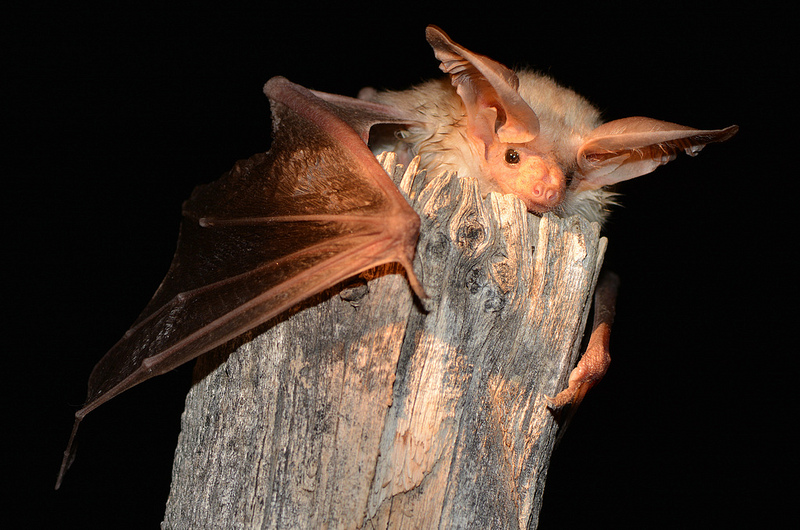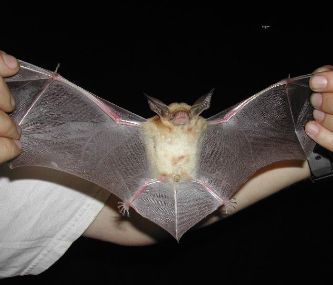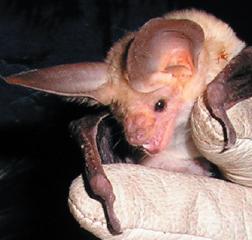Interactions/Nutrition
As an insectivorous bat, Antrozous pallidus is well known for its predation of arthropods (Frick et al., 2009). Pallid bats will swoop down and catch flying insects below them and even pick them off of the ground. They have also been documented gleaning small insects from plants (Frick et al., 2009). These bats are part of the Vespertilionidae family and are a nocturnal bat. Therefore, to locate their prey, they use echolocation to determine where they can catch their next meal in the blackness of the night. An interesting adaptation in diet that A. pallidus developed in the hunt for moths (see a similar species of moth here) in Baja California, Mexico was a desire for the pollen from the flowers of Pachycereus pringlei (a similar species of cactus is found here) a cardon cactus (Frick et al., 2009).
Oddly enough, these pallid bats developed a mutualistic relationship
with this cactus by following moths to the flower of the cactus
(Frick et al., 2009). The
flower of P. pringlei is rather deep so these short-nosed
bats had to put their entire face into the middle to reach a moth
that had flown inside. A study done in 2009 by Frick et al. showed
that A. pallidus not only went to these flowers to catch
moths but, also to drink the nectar. This finding was important to
the science community, because while it is known that many different
predatory mammals have adopted an omnivorous diet, this is the first
of the insect eating bats. The successful mutualism with
Pachycereus pringlei was another important finding because
there is another bat (Leptonycteris yerbabuenae) in this
same habitat that already aids in the pollination of these flowers
(Frick et al., 2009).
L.
yerbabuenae (another interesting species of bat is seen
here) are more commonly known as the Mexican lesser long-nosed
bats and are a nectar eating bat. As their name indicates, they have
a long nose so they can reach into the deep flowers of this cactus
and drink the nectar with ease (Frick et al., 2009). Both of these species of bat have
developed a mutualistic relationship with P. pringlei in a
similar manner to that of a bee (read about a specific bee
population that does this
here) pollinating a flower. By traveling to and drinking the
nectar of one the flower, the bat will get some nectar on its face
and by traveling to another cactus flower the bat is aiding in
pollination (Frick et al., 2009). It was found that A. pallidus is much more
effective in pollination because of the way they drink from the
flower. Since they have such a short nose, they have to delve much
deeper into the flower and therefore get a face full of pollen
instead of a nose-full. When they travel to the next flower, they
are carrying a much greater amount of pollen and are facilitating a
higher pollination rate (Frick et al., 2009).
The
relationship between A. pallidus and L. yerbabuenae
remains to be unknown. It appears that there may be some competition
between these two bat species, however they seem to have more of an
avoidant behavior towards another (Frick et al., 2009). The pallid
bats often seemed to feed off of the cardon cactus flowers in the
early hours of the morning while the Mexican lesser long-nosed bats
appeared by these flowers in the first few hours of darkness (Frick
et al., 2009).
Further research is needed on these species interactions to know
what kind of relationship they have with another.
Return to Reproduction Go to Interesting Facts
Return Home




